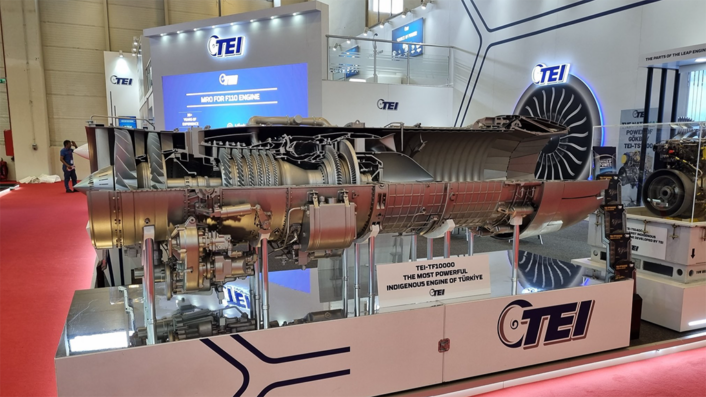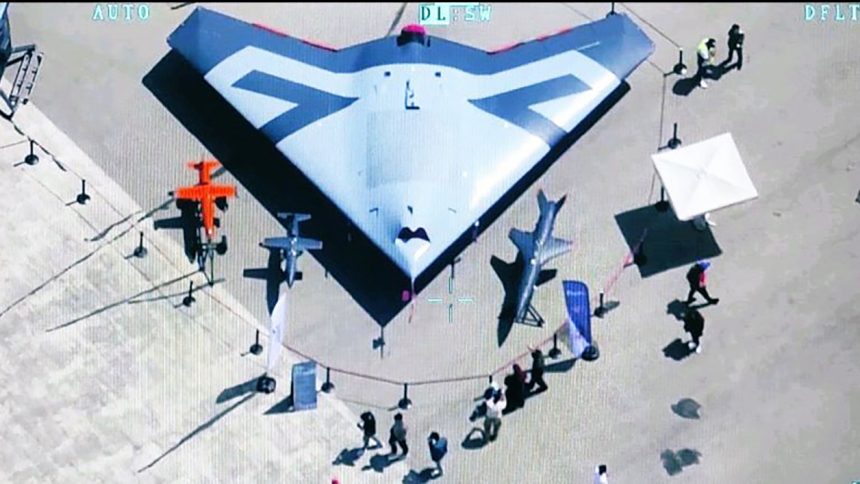Turkey’s ANKA-3 UCAV (Unmanned Combat Aerial Vehicle) will soon fly with two engines and reach supersonic speeds, Turkish Aerospace Industries says.
Turkey has been rapidly moving towards fielding UCAVs that can fly supersonic, team up with other manned/unmanned aircraft and fire missiles. During a recent online interaction, the CEO of Turkish Aerospace Industries (Türk Havacılık Uzay Sanayii or TUSAS), Temel Kotil, said that the ANKA-3, will have two engines, which will allow it to fly at “supersonic speeds.”
“Now ANKA-3 is at high subsonic speed. But its 2-engine version will arrive soon, it will also be supersonic and will accompany KAAN,” he was quoted by Turan Oguz, a leading Turkish defense policy analyst on X.
🇹🇷 @TUSAS_TR Genel Müdürü @Temel_Kotil:
“Şimdi ANKA-3 yüksek ses altı hızda. Ama onun 2 motorlusu gelecek yakında o da süpersonik olacak ve KAAN’a eşlik edecek.”
Gelecekte ANKA-3’ün 2 adet TEI-TF10000 turbofan motor ile uçması bekleniyor. TEI-TF10000’in geliştirme çalışmaları… pic.twitter.com/CVEc7fhTxv
— Turan Oguz (@TyrannosurusRex) May 23, 2024
Oguz also identified the engines as two TEI (TUSAŞ Engine Industries) TF10000 turbofan power plants. “Development work on TEI-TF10000 continues and when completed, it is aimed to provide 6,000-pounds of dry and 10,000-pounds of afterburner (A/B) thrust.”

Interestingly, the TF10000, along with the TF6000 is being rapidly developed to serve as a domestic alternative to the US-made General Electric GE F110 turbofan – that currently powers the KAAN. Ankara is anticipating that complicated US-Turkey ties might lead to Washington blocking the sale of F110s. The TF10000 is and upgraded version of the TF6000, where the latter is being developed as the auxiliary power unit for the KAAN.
Tusaş Genel Müdürü Temel Kotil :
Anka-3’ten Süper Şimşek’i fırlattığımız zaman,havadan havaya olan bu füze,düşmanın içinden geçecek ve hedefi 12 den vuracak.
Süper şimşek 36 kg harp başlığına sahip ve aralarında elektronik harp,elektronik destek gibi 11 farklı görevde… pic.twitter.com/IKNKSO7zTR
— Turkish Defence Agency (@tdefenceagency) May 18, 2024
ANKA-3
The Turkish ANKA-3 UCAV is one of the most interesting programs of the prolific and successful Turkish aerospace industry. Developed by TAI, the flying wing type stealth UCAV features a wingspan of roughly 17.5 meters and a length of about 8 meters, designed to handle various mission types with a maximum takeoff weight of 6.5 tonnes and payload of 750 kg.
The first prototype made its first flight on December 28, 2023.
At the moment, the ANKA-3 is equipped with a single AI-322 engine that allows the UCAV to fly at the top speed of 450 knots. The service ceiling is 12,000 meters (39,000 feet), with a maximum ceiling of 40,000 feet (12,000 meters). The future version of the ANKA-3 will be probably larger and capable of carrying a heavier payload, with a shape that will need to be revised and optimized for supersonic speeds.
While it possesses sophisticated features and advanced technology, the ANKA-3’s primary role is more aligned with traditional UCAV operations rather than acting as a loyal wingman (for the KAAN). It can perform ISR missions, carry precision-guided munitions, and conduct electronic warfare and will be capable of autonomous flight and mission execution (although probably managed or monitored by ground stations).
On May 18, 2024 a top view photograph of what is said to be the second prototype of the ANKA-3 was circulated online. The aircraft has reportedly carried out the ground testing and should be ready to fly soon. The most notable difference from the first prototype is the new paint scheme.
🇹🇷 Yeni boyasıyla @TUSAS_TR ANKA-3 insansız savaş uçağının 2’nci prototipi.
Yer testleri dün başladı. Yakında o da uçacak.
Sağında ve solunda da Şimşek ve Süper Şimşek YİHA. pic.twitter.com/1XVco1cuFC
— Turan Oguz (@TyrannosurusRex) May 18, 2024
Interestingly, the new photograph shows the UCAV next to the Şimşek (Lightning) – on its right hand side – and its larger and higher-performance Süper Şimşek (Super Lightning) unmanned aircraft – on its left hand side.
Initially developed as a target UAV, the Şimşek has evolved into a family of air-launched drones that can be able to carry out a wide variety of autonomous missions, including “kamikaze” ones.
Tusaş Genel Müdürü Temel Kotil:
Anka-3’ten Süper Şimşek’i fırlattığımız zaman,havadan havaya olan bu füze,düşmanın içinden geçecek ve hedefi 12 den vuracak.
Süper şimşek 36 kg harp başlığına sahip ve aralarında elektronik harp,elektronik destek gibi 11 farklı görevde… pic.twitter.com/IKNKSO7zTR
— Turkish Defence Agency (@tdefenceagency) May 18, 2024
The Şimşek/Süper Şimşek can be equipped with different seekers/warheads to be used for air-to-surface and air-to-air missions, as well as electronic warfare and SEAD support, or be used as a decoy or as part of a swarm of drones in a “loyal wingman” scenario. A “cruise missile” variant, with a range of about 700 km, is also being considered.
TUSAŞ, ŞİMŞEK hedef İHA’sının son versiyonunu ANKA-3 İHA’nın yanında sergiledi
📷 @kaanazm1 pic.twitter.com/3Ti2CcGrKP
— Oğuzhan Uygun (@ogzhn_uyg) May 25, 2024
Turkey Moving Drones Firing Air-to-Air Missiles
The development of the ANKA-3 and its supporting ecosystem speak volume about the specific techno-tactical direction of the Turkish industry, which has been rapidly moving forward on fielding UCAVs that can also fire air-to-air missiles. For instance, the Akinci is one UCAV envisaged for releasing the Gokdogan AAM.
While presenting its own sets of challenges, such paradigm offers certain advantages.
Gürcan Okumuş, Director General of TUBITAK-SAGE, was quoted in Daily Sabah in July 2022: “With these missiles, we aim to see without being seen and to be able to hit from far away. It will be much easier for us to do this with our missiles. High technology is not easily shared between countries, or even not shared at all. It is not possible to easily acquire these from abroad through technology transfer. Therefore, the output of every project here is a new achievement.”
For one, it is difficult for UAVs to undertake the tight maneuvering at supersonic speeds in aerial combat owing to the control lag in the radio or satellite link between the ground operator and the aircraft. The aggressive aerobatics would be even difficult for propeller-driving drones like the Akinci. Possibly, the Kizilelma, touted as the future loyal wingman for the KAAN, would come closer to this capability.
TUSAŞ Genel Müdürü Prof. Dr. Temel Kotil:
“Milli Muharip Uçak KAAN’ın etrafında ANKA-3, Kızılelma, ANKA-4 veya daha sonra çıkacak olanlar var.” pic.twitter.com/QFKgalT2zC
— Sanayi ve Savunma 🇹🇷 (@SanayiSavunmaTR) May 26, 2024
This live link is also vulnerable to detection and jamming by enemy EW (Electronic Warfare). Unless the UAVs are fully autonomous, that can perform calculated and complex mission sets without human intervention, this would be impossible. Flight control software and algorithms in semi-autonomous and autonomous flight are only at their nascent stages.
Secondly, arming drones with heavier active or passive radars for air combat will entail challenges in airframe design that would have to accommodate fire control systems. A UAV/UCAV already carries GPS receivers, satellite links, and heavy electro-optical systems.
Effort is not Pointless
Despite the challenges, firing ultra-long-range AAMs from UAVs is also not a futile endeavour, especially if the particular air force has a host of other supporting platforms like AWACS aircraft, satellites and at least Generation 4++ fighters (if not Gen. 5) jets.
These should trade information with the BVR AAM-firing drone through powerful, high-bandwidth jam-proof data links. These should be much more advanced than the US and NATO’s Link 16, somewhere close to the F-35’s MADL (Multifunction Advanced Data Link). In other words, AAM-firing drones would be mere standoff weapons release platforms with targeting data received from other aerial assets, as low-cost, human-casualty free solutions to keep enemy aircraft at bay, with manned fighters as a backup.
And Turkey is not the only military officially envisaging these goals.
Indonesian Air Force (IdAF) chief Air Chief Marshal Tony Harjono on April 22 this year, while announcing plans to acquire Chinese CH-4 and Turkish ANKA and Bayraktar drones at Bantul in Yogyakarta, declared they would develop a UAV that can fire BVR missiles.
Harjono said: “There will be a new unmanned aerial vehicle to complement the national weapons system.The unmanned aircraft will use satellite technology to support beyond-visual-range (BVR) or long-range air combat,” he added.
“We can operate it from outside the area that we want to monitor; for example, in Papua or any other area, we can fly it from outside Papua,” Harjono said at the event, celebrating the 78th anniversary of the Indonesian Air Force. He explained that the UAVs being imported include “the CH-4, Anka, and Medium Altitude Long Endurance (MALE) Bayraktar drones”, the report said.









